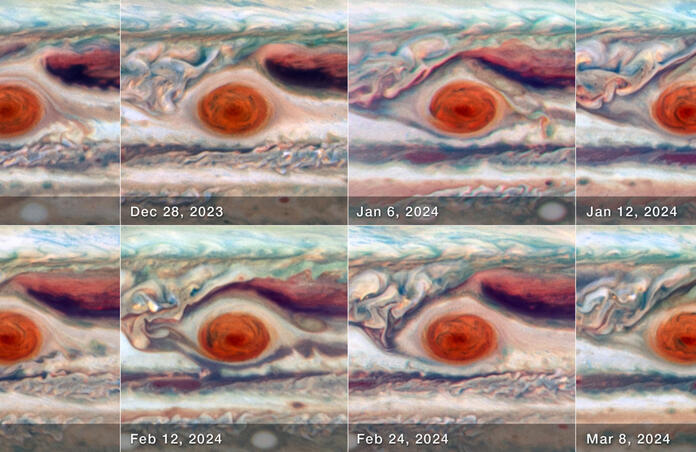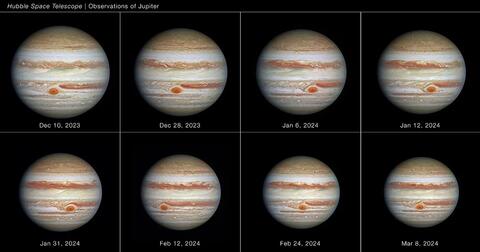New observations find Jupiters Great Red Spot shrinking and expanding

Hubble has made new observations of Jupiters Great Red Spot, revealing that the anticyclone is not as stable as it might appear. The images provide an opportunity of watching a time-lapse movie of the spots behaviour, showing it wobbling like a bowl of jelly.
"While we knew its motion varies slightly in its longitude, we didn't expect to see the size oscillate. As far as we know, it's not been identified before," said Amy Simon of NASA's Goddard Space Flight Center in Greenbelt, Maryland, lead author of the science paper published in The Planetary Science Journal. "This is really the first time we've had the proper imaging cadence of the GRS. With Hubble's high resolution we can say that the GRS is definitively squeezing in and out at the same time as it moves faster and slower. That was very unexpected, and at present there are no hydrodynamic explanations."
The Outer Planet Atmospheres Legacy Program (OPAL) is led by Simon, which monitors the outer solar system planets annually. However, the new observations were part of a different program dedicated solely to the GRS. Studying this feature is important since understanding the mechanisms behind the largest storms in the solar system can be used to contextualise our knowledge about hurricanes on earth and extend this to extrasolar planets.

The team used Hubble to zoom in on the GRS allowing for detailed study of its size, shape and any subtle changes in colour. UV observations show that the core of the storm increases in brightness when the GRS is at its largest size in the oscillation cycle. This suggests less haze absorption in the upper atmosphere.
"As it accelerates and decelerates, the GRS is pushing against the windy jet streams to the north and south of it," said co-investigator Mike Wong of the University of California at Berkeley. "It's similar to a sandwich where the slices of bread are forced to bulge out when there's too much filling in the middle."
This is different to Neptune, where dark spots can vary by a range of latitudes without strong jet streams suppressing them. Jupiters GRS has been held at a southern latitude, trapped between the jet streams for as long as we have been observing using ground-based telescopes. The group of researchers have been watching the spot shrink since the OPAL program began a decade ago, predicting that this shrinking will continue until a stable, less elongated shape is reached.
"Right now it's over-filling its latitude band relative to the wind field. Once it shrinks inside that band the winds will really be holding it in place," said Simon.
For now, Hubble has only observed one oscillation cycle. The team hope that other future high-resolution images taken from Hubble may identify other Jovian parameters that point towards the underlying cause of the oscillation.
--
Cover image: NASA, ESA, Amy Simon (NASA-GSFC); Image Processing: Joseph DePasquale (STScI)
Journal source: Amy A. Simon, Michael H. Wong, Phillip S. Marcus, Patrick G. J. Irwin. A Detailed Study of Jupiter’s Great Red Spot over a 90-day Oscillation Cycle. The Planetary Science Journal, 2024; 5 (10): 223 DOI: 10.3847/PSJ/ad71d1
